The audio guide to the Hiraizumi, the designated world heritage site of history and culture of the northern Fujiwara clan
Hiraizumi area
Hiraizumi is a famous historic area located in the Southwest part of Iwate Prefecture.
In the latter half of the Heian era, Hiraizumi was chosen by the head of the northern branch of the powerful Fujiwara clan to create a utopian city that would last throughout history. The construction required 100 years to complete. The city became a center of culture and politics in Japan. The structures of Hiraizumi are notable for their distinct architecture that expresses clear connections with buddhism. These structures would later be designated as world heritage sites by UNESCO in 2011. Among the famous sites are impressive structures such as Chusonji Temple and Motsuji Temple. Some structures have histories dating back more than 1200 years. There are also famous natural sites in the area, such as the ravines of Genbikei and Geibikei.
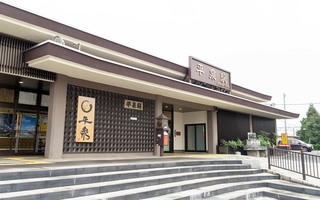
A Hiraizumi Station
B Hiraizumi Cultural Heritage Center
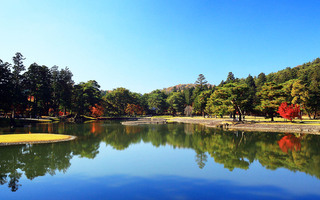
C Motsuji Temple
D Chusonji Temple
E Takkoku no Iwaya, Bisyamondo
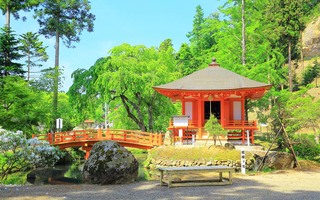
F Gamagaike Bentendo
G Roadside Station , Genbikei
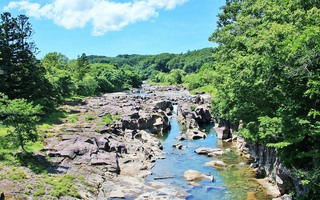
H Genbikei Gorge
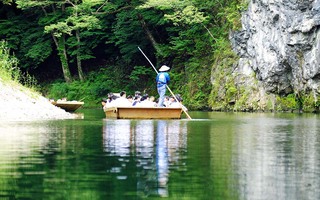
I Geibikei Gorge
03-008-10%E5%B2%A9%E6%89%8B%E7%9C%8C%E4%B8%80%E9%96%A2%E6%B8%A9%E6%B3%89%E9%83%B7%20%E7%9C%9F%E6%B9%AF%E6%B8%A9%E6%B3%89.jpg)
J Iwate Prefecture Ichinoseki Shinyu Hot Springs
A
Hiraizumi Station

Hiraizumi station is a JR East station in the town of Hiraizumi, Iwate prefecture. The station was opened in 1898 and was designated as a national railway station. In 2002, Hiraizumi Station was selected as one of the most notable of ”Train Stations in Tohoku“, but since the station building suffered extensive damage due to the Great East Japan Earthquake, it was redone in 2012. A waiting space and tourist information center were added and the rebuilt station harmonizes with the surrounding landscape, borrowing from the architectural style of the renowned buildings found in the area. In the vicinity of the station, ruins remaining from the Northern Fujiwara clan that prospered around the 12th century can be found. Northwest of the station is Chusonji temple, Motsuji Temple grounds and other historical sites. Special historic sites and World Heritage sites are located close to the station and you can enjoy sightseeing by using a rental cycle or taxi from the station, or visit the historical heritage sites using the Hiraizumi tour bus "RUNRUN".
B
Hiraizumi Cultural Heritage Center
The Hiraizumi Cultural Heritage Center is a facility that shares the impressive history of the Hiraizumi area which has been registered as a World Heritage Site. In the exhibition space, there is an exhibit on the history of Hiraizumi from it's origin through to today. There is a topographical model of the area and an interesting exhibition of excavated historical artifacts. Because of the many archaeological materials that have been excavated in the area, you can learn about Hiraizumi history and culture and gain insight on the development of the area over the past 800 years. Among the many exhibits, one of the most interesting is the ”Chusonji Lotus”. The ”Chusonji Lotus” is an amazing story connected with the fourth generation ruler of the Fujiwara clan (Fujiwara no Yasuhira), who was beheaded in 1189. Lotus seeds that had been entombed with the mummified head of the deceased leader, were taken out and blossomed 800 years later. This flowering spectacle is one of the few connections we have with the powerful clan that once ruled much of Japan. In addition to permanent exhibitions there are numerous events including special exhibits.
C
Motsuji Temple

Motusji Temple is a temple belonging to the Tendai sect of Buddhism in Hiraizumi. This was once a large and important temple when the city of Hiraizumi prospered as a cultural and political center in northern Japan. The gardens are said to have been made in 850 by Jigakudaishi Enin, the third head of the temple. The beautiful gardens of Motsuji Temple still remain as they did throughout the rise and fall of the Fujiwara clan. The expansive garden reflects the popular garden style of the times which tried to recreate the concept of a buddhist paradise, or pure land. There is a large pond in the middle of the garden which is the centerpiece of the design. In 2011, it was registered as a World Heritage Site as one of the representative archeological sites of the Hiraizumi area. In January of every year there is a event called the Ennen no Mai, Noh drama plays that have been passed down for more that 800 years. These Noh plays were designated as Important Folk Cultural Properties in 1977. The temple is one of four on the popular temple course called the Shihikairo.
D
Chusonji Temple
Chusonji is a temple belonging to the Tendai sect of Tohoku Bunkyo, located in Hiraizumi Town and known as the temple of the famous Northern Fujiwara Clan. It was registered as a World Heritage Site in 2011 as being a site of historic and cultural value with many cultural properties, including the Buddhist temple with a gold leafed hall known as Konjikido. The Konjikido is said to have been erected in the late Heian period as a resting place for the souls that were lost in the many battles for control of the Northern region of Japan. Konjikido was built by Kiyohira, the founder of the northern Fujiwara clan in 1124 and is designated as a national treasure of Japan. It contains buildings that represent the aesthetics and design of Pure Land Buddhism architecture at the time. The interior is divided into three rooms, which are covered in gold leaf on the inside and outside of the building. The casket below the altar holds the remains of 4 members of the Fujiwara Clan. On the temple grounds is the eternal flame, said to have been lit continuously since the times of the famous buddhist priest Saicho. The temple is still an important place of worship for the followers of the Tendai sect of Buddhism in northern Japan.
E
Takkoku no Iwaya, Bisyamondo
Takoku no Iwaya is a picturesque cliffside temple dating back 1200 years to the height of the Northern Fujiwara clan's reign. The temple was founded by Sakanoue no Tamuramaro in 801 to commemorate victories over the indigenous people of the north. The temple is built over a small cave containing a statue of the Bishamonten, the armor clad god of war. Sakanoue no Tamuramaro believed that it was through the guidance of the god Bishamonten that allowed him to be victorious in the region and has since attracted many people who pray for their own victories in various fields and endeavors. Within the temple is the Joroku fudo myo-o Statue dating back to the Heian era. The temple grounds have been designated as a National Historic site of Japan.
F
Gamagaike Bentendo

Gamagaike is said to be a “Pond of the Gods” located in front of Takkoku no Iwaya Bishamondo. It was built by Sakanoue Tamuramaro, a general and shogun of the Heian era, and the animals that live there are said to be used by the Benten god. It is forbidden to kill anything, including animals on the temple grounds. Around 829, Jikaku Daishi went on a journey of Eastern Pilgrimage and along the way met with a large five-colored toad who was the incarnation of the Binbo gami, a god who would bring misery and poverty to households. The toad was caught and brought in front of the Bishamonten enshrined at the Takkoku no Iwaya. The story continues with the toad being brought before the goddess Ugajin, also known as Benzaiten (a goddess associated with the prosperous flow of money and success.) The toad's head was chopped off and enshrined at the pond. Now the pond is a popular place for those in business and commerce to come and pray for prosperity.
G
Roadside Station , Genbikei
This roadside station is located at the “Entrance to Southern Iwate” the Ichinoseki hot spring area, known as the Mochi to Yu no Sato. It is near the beautiful natural site of Genbikei and is popular as a stop for shopping, eating, and rest for people visiting the attractions in the area. You can see and buy local fresh produce, popular local specialities, and learn a bit more about the culture and history of the area. It is also reknowned for it's many types of MOCHI. At Pettankun, a restaurant located in the roadside station, there are 8 types of mochi, pounded rice cakes. Every fourth Friday of the month there is a popular “All you can eat” mochi. This roadside station keeps the proud local tradition of mochi eating alive with “Japan`s Best Mochi Culture.”
H
Genbikei Gorge

Genbikei is a famous 2km gorge located in Iwate prefecture`s Ichinoseki City. The flow of the river between the strange and weathered rocks formed by erosion of the flowing river, and the lush green and autumn leaves that color the area are beautiful any season. In 1927 it was designated as a scenic spot and place of natural beauty by Japan. The scenery changes with the seasons and you can enjoy cherry blossoms in spring, the lush greenery in summer, the colorful leaves of fall, or the beautiful snow covered scenes in winter. It is said that Date Masamune, known as one of the most famous Sengoku Daimyo, visited this area and was overjoyed with the scenery. There is a fun and interesting way to enjoy some local mochi, sweet pounded rice cakes, when visiting the gorge. When you put money in a basket on one side of the river, the "Kakko Dango" will send you dango mochi and tea from a teahouse on the other side of the river. This is a popular tourist attraction and a delicious local treat to try.
I
Geibikei Gorge

Geibikei is a beautiful gorge located in the southern part of Ichinoseki City in Iwate Prefecture. Geibikei and Genbikei are known as wonderful scenic spots to enjoy the natural beauty of Japan. The area was relatively unknown, even to locals, until Iwate Prefecture named it the first “Scenic Spot” of the prefecture in 1923. The area is known as the “Yabakei of the North” for it`s resemblance to the popular gorge located in southern Oita Prefecture. The river flows between limestone cliffs reaching heights of 100m, and strange rocks and waterfalls are scattered everywhere, creating a fantastic scenery. Take a leisurely boat ride down the river between the towering limestone cliffs, take in the exquisite scenery, and enjoy stories and songs from your boat's skipper. The boat is guided with a long stick known as a “Sao” that pushes the sendou (boat) along. The area is especially popular for the autumn leaf landscapes. In the winter the boats are fitted with heated seats; referred to as “Kotatsu Bune.” Along the river is a place to stop and try your luck at throwing a rock through an opening on the opposite cliffside. Choose from 10 different rocks symbolizing different wishes, such as love, money, success, health and more. Send your “Untama” through the hole and your wishes are said to be granted.
J
Iwate Prefecture Ichinoseki Shinyu Hot Springs
03-008-10%E5%B2%A9%E6%89%8B%E7%9C%8C%E4%B8%80%E9%96%A2%E6%B8%A9%E6%B3%89%E9%83%B7%20%E7%9C%9F%E6%B9%AF%E6%B8%A9%E6%B3%89.jpg)
Iwate Prefecture's Ichinoseki Onsenkyo Shinyu hot springs is an area located in the western part of Ichinoseki city. It is known for it's strongly acidic "Sukawa Onsen" and a place of healing. This hot spring was discovered around 1846 where injured deer were seen to be tending to their wounds, hence it's name derived from the Japanese words for deer and hot water. Now people visit the springs for their ailments. From the lush green of summer to the colorful leaves of autumn, this is a wonderful place to enjoy while experiencing the changing landscape of the seasons. There are cottages available for rent next to the “Jabu Jabu Hiroba” directly opposite from the hot spring. And the facilities also include walking trails, tennis courts, and more.